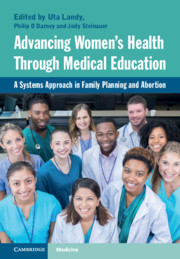 Advancing Women's Health Through Medical Education
Advancing Women's Health Through Medical Education Book contents
- Advancing Women’s Health Through Medical Education
- Reviews
- Advancing Women’s Health Through Medical Education
- Copyright page
- Dedication
- Contents
- Contributors
- Preface
- Acknowledgments
- Introduction
- Section I Abortion Training: Workforce, Leadership, Social & Political Impact
- Section II Integration of Abortion into Graduate Medical Education
- Section III Family Planning Curricular Design & Implementation
- Chapter 17 A Guide for Creating a Program in Sexual and Reproductive Health-Care Education
- Chapter 18 Creating and Implementing a Curriculum for Reproductive and Sexual Health Training Programs
- Chapter 19 Assessing Competence in Family Planning Skills through Milestones
- Chapter 20 Educating and Mentoring Medical Students in Family Planning
- Chapter 21 The Role of Students in Advocating for Training in Sexual and Reproductive Health Care
- Chapter 22 The Role of Simulation in Sexual and Reproductive Health-Care Training
- Chapter 23 The Benefits of and Strategies for Supporting Residents’ Partial Participation in Abortion Training
- Chapter 24 Stigma and Abortion Care
- Chapter 25 Emotional Support
- Section IV Reproductive Health Services & Abortion Training: Global Examples
- Index
- References
Chapter 24 - Stigma and Abortion Care
Implications for Training
from Section III - Family Planning Curricular Design & Implementation
Published online by Cambridge University Press: 30 July 2021
- Advancing Women’s Health Through Medical Education
- Reviews
- Advancing Women’s Health Through Medical Education
- Copyright page
- Dedication
- Contents
- Contributors
- Preface
- Acknowledgments
- Introduction
- Section I Abortion Training: Workforce, Leadership, Social & Political Impact
- Section II Integration of Abortion into Graduate Medical Education
- Section III Family Planning Curricular Design & Implementation
- Chapter 17 A Guide for Creating a Program in Sexual and Reproductive Health-Care Education
- Chapter 18 Creating and Implementing a Curriculum for Reproductive and Sexual Health Training Programs
- Chapter 19 Assessing Competence in Family Planning Skills through Milestones
- Chapter 20 Educating and Mentoring Medical Students in Family Planning
- Chapter 21 The Role of Students in Advocating for Training in Sexual and Reproductive Health Care
- Chapter 22 The Role of Simulation in Sexual and Reproductive Health-Care Training
- Chapter 23 The Benefits of and Strategies for Supporting Residents’ Partial Participation in Abortion Training
- Chapter 24 Stigma and Abortion Care
- Chapter 25 Emotional Support
- Section IV Reproductive Health Services & Abortion Training: Global Examples
- Index
- References
Summary
Abortion stigma is a phenomenon in many regions and cultures. Those receiving training in clinical abortion care should understand abortion stigma both as a theoretical concept and as a lived experience for the abortion-care workforce. Indeed, one of the most challenging aspects of abortion care is managing and negotiating the stigma that often comes with it.In this chapter we define abortion stigma, and discuss its impact on people who seek abortion and on those who care for them.We introduce key concepts in stigma dynamics, in particular the ways in which stigma and silence create vicious cycles that affect psychosocial well-being, abortion complications, and law and policy.We consider the ways in which training settings bring unique stigma-related challenges for both trainer and trainee, including learner dilemmas about seeking abortion training, disclosing abortion training, and interacting with other healthcare providers who may be opposed to abortion.We conclude by reviewing strategies for managing stigma and developing resilience to its consequences, including values clarification trainings and the Provider's Share Workshop.
Keywords
- Type
- Chapter
- Information
- Advancing Women's Health Through Medical EducationA Systems Approach in Family Planning and Abortion, pp. 240 - 252Publisher: Cambridge University PressPrint publication year: 2021
